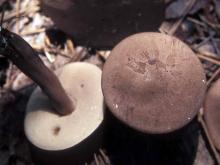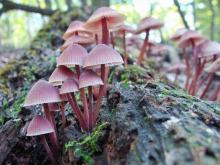Mushrooms
Media

Species Types
Scientific Name
Tylopilus plumbeoviolaceus
Description
The violet-gray bolete has a large, violet-gray cap with cream-pink pores, and a violet stalk that is sometimes webbed. It grows scattered on the ground in mixed woods.
Media

Species Types
Scientific Name
Daedaleopsis confragosa (Daedalea confragosa)
Description
The thin-maze flat polypore is a grayish brown bracket fungus with a zoned top and a furrowed, mazelike underside. It grows singly or in small, layered clusters on dead wood or in wounds of living trees.
Media

Species Types
Scientific Name
Trichaptum biforme
Description
The violet toothed polypore is a bracket fungus with tough, hairy caps with violet margins and zones of white, brown, and black; beneath, the whitish violet pores break into teeth. It grows on stumps and logs of deciduous wood.
Media

Species Types
Scientific Name
Polyporus badius
Description
The black-footed polypore has a smooth, wavy brown cap with whitish or tannish pores on the underside and a black, smooth, off-center stalk. It grows singly or in groups of up to several on dead wood and stumps of deciduous trees.
Media

Species Types
Scientific Name
Tylopilus felleus
Description
The bitter bolete has a large, tannish brown cap with pinkish white pores and a webbed, tannish brown stalk. It grows singly or scattered on the ground in mixed woods.
Media

Species Types
Scientific Name
Amanita spp. (about 600 species, worldwide)
Description
This large group of mushrooms accounts for 90 percent of mushroom-related deaths, so every mushroom hunter should be familiar with amanitas. They contain one of the deadliest poisons found in nature!
Media

Species Types
Scientific Name
Mycena haematopus
Description
The bleeding mycena is a small mushroom with a bell-shaped, reddish brown cap that bleeds dark red when cut. It usually grows in clusters on decaying wood.
Media

Species Types
Scientific Name
Amanita rubescens
Description
The blusher has a tan to reddish brown cap with pinkish brown patches and a ring on the stalk; the entire mushroom bruises reddish. It grows on the ground in oak woods and under white pines.
See Also



Media

Species Types
Scientific Name
Monotropa hypopitys
Description
Pinesap is a plant that puts the "wild" in wildflower! It lacks chlorophyll, so its roots connect to fungi underground and absorb nutrients from the fungi.
Media

Species Types
Scientific Name
Cladophora, Pithophora, and Spirogyra spp., and others
Description
Filamentous green algae forms green, cottony masses that are free-floating or attached to rocks, debris, or other plants.
Media

Species Types
Scientific Name
Monotropa uniflora
Description
Indian pipe lacks chlorophyll, so it is white, not green. Below ground, its roots join with fungi that connect to tree roots. This plant, then, takes nourishment indirectly from the trees.
About Mushrooms in Missouri
Mushrooms are a lot like plants, but they lack chlorophyll and have to take nutrients from other materials. Mushrooms are neither plants nor animals. They are in a different kingdom — the fungi. Fungi include the familiar mushroom-forming species, plus the yeasts, molds, smuts, and rusts.
Always be cautious when eating edible mushrooms. Be absolutely sure of the ID, and only eat a small amount the first time you try it to avoid a reaction..





















